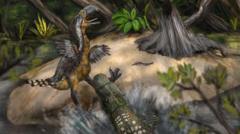The researchers say the terror bird did not survive the encounter. Teeth marks found on the leg bone of a large avian reptile known as a terror bird, dating back 13 million years, indicate it may have been killed by an even larger predator, scientists claim. Terror birds, recognized as top predators of their time, could exceed human height and possessed strong legs along with hooked, flesh-tearing beaks. A team of palaeontologists in Colombia has matched bite marks on the fossilized leg bone of one of these fearsome birds to those of a caiman, a reptile resembling modern crocodiles. Through 3D digital scans, the scientists were able to reconstruct what seems to be a "battle to the death," suggesting that the terror bird did not survive this encounter.
The findings, published in Biology Letters, involved comparing the size and shape of the teeth marks with skulls and teeth of crocodile-like predators from museum collections. This offers significant evidence of interaction between two extinct apex predators. The leg bone in question was discovered over 15 years ago in Colombia's Tatacoa Desert, a site known for rich fossil deposits from the Middle Miocene epoch. The ecosystem, characterized by humid swamps, preserved the bones of various dead animals, including the terror bird, which stood around 2.5 meters tall and used its legs and beak to capture prey.
While it remains uncertain if this specific terror bird was killed in the attack, or if the caiman simply scavenged its remains, the lack of healing in the bone's bite marks implies the bird did not survive the encounter. Lead researcher Andres Link from the Universidad de Los Andes in Bogotá remarked, "If it wasn't already dead, it died in the attack. That was the last day that bird was on this planet." The Tatacoa Desert has provided a wealth of fossils, and this particular leg bone was first recognized as belonging to a terror bird thanks to local fossil collector César Augusto Perdomo.
In collaboration with Mr. Perdomo, the Colombian scientists studied various fossils, ultimately leading to the identification of the leg bone as that of the rare terror bird. Their analysis further revealed that the teeth marks were most consistent with those of an extinct caiman species called Purussaurus neivensis, which could have reached lengths of up to five meters. It is believed this giant predator would have ambushed prey from the water's edge, similar to modern-day crocodiles. Dr. Link suggests that this instance may offer critical insights into the ancient ecosystem, revealing that terror birds were likely much more vulnerable to other predators than previously imagined. "Every piece of a body helps us to understand so much about life on the planet in the past," he commented, emphasizing the importance of fossils in understanding historical life on Earth.
The findings, published in Biology Letters, involved comparing the size and shape of the teeth marks with skulls and teeth of crocodile-like predators from museum collections. This offers significant evidence of interaction between two extinct apex predators. The leg bone in question was discovered over 15 years ago in Colombia's Tatacoa Desert, a site known for rich fossil deposits from the Middle Miocene epoch. The ecosystem, characterized by humid swamps, preserved the bones of various dead animals, including the terror bird, which stood around 2.5 meters tall and used its legs and beak to capture prey.
While it remains uncertain if this specific terror bird was killed in the attack, or if the caiman simply scavenged its remains, the lack of healing in the bone's bite marks implies the bird did not survive the encounter. Lead researcher Andres Link from the Universidad de Los Andes in Bogotá remarked, "If it wasn't already dead, it died in the attack. That was the last day that bird was on this planet." The Tatacoa Desert has provided a wealth of fossils, and this particular leg bone was first recognized as belonging to a terror bird thanks to local fossil collector César Augusto Perdomo.
In collaboration with Mr. Perdomo, the Colombian scientists studied various fossils, ultimately leading to the identification of the leg bone as that of the rare terror bird. Their analysis further revealed that the teeth marks were most consistent with those of an extinct caiman species called Purussaurus neivensis, which could have reached lengths of up to five meters. It is believed this giant predator would have ambushed prey from the water's edge, similar to modern-day crocodiles. Dr. Link suggests that this instance may offer critical insights into the ancient ecosystem, revealing that terror birds were likely much more vulnerable to other predators than previously imagined. "Every piece of a body helps us to understand so much about life on the planet in the past," he commented, emphasizing the importance of fossils in understanding historical life on Earth.



















